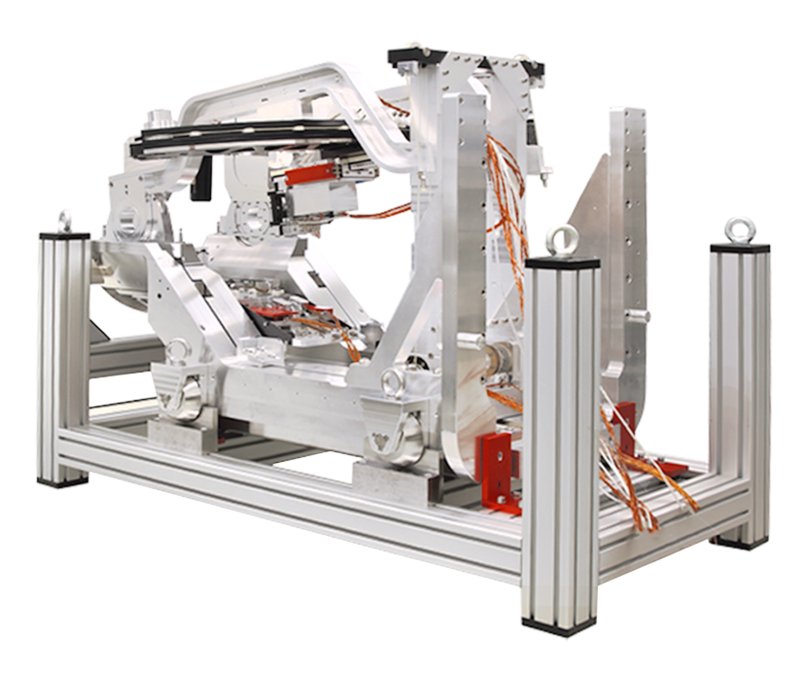Special order in the service of research: positioning specialist Steinmeyer Mechatronik was commissioned to develop a sample manipulator for an experiment at the electron storage ring BESSY II in Berlin. Not only did it have to be flexible and highly precise, it also had to withstand vacuum and magnetism. The company used drives from PiezoMotor for this challenging task.
The researchers, who approached the Dresden-based company Steinmeyer Mechatronik, aimed to make magnetism visible in three dimensions on living circuits. For their experiment, the scientists needed extremely brilliant X-ray light, such as that produced by the synchrotron radiation source BESSY II. Researchers all over the world can use this light source for their experiments, for example to study solar cells, materials for solar hydrogen production or quantum materials. State-of-the-art spectroscopy and microscopy methods are available to them at the beam tubes on the side of the storage ring.
"The so-called RICXS experiment consisted of a larger setup with several elements, including a sample manipulator, a camera with a guide and a sample fixture," explains Elger Matthes from Steinmeyer Mechatronik. The company specializes in high-precision positioning tasks and offers innovative products and customer-specific solutions for individual tasks. Steinmeyer Mechatronik focuses on the development and production of OEM series and complex multi-axis systems, as well as custom-made products for experimental tasks such as those of the Berlin researchers.
For the RICXS experiment, a 5-axis manipulator was to be created that lifted an electronic circuit fixed on a column into the magnetic field of a superconducting vector magnet, where it was exposed to an intense light source. "The scattered radiation was captured by an orbiting camera, which used it to compose three-dimensional images," says Matthes, explaining the principle. As this required a specific, very short-wave spectrum of X-rays, the experiment only worked in an ultra-high vacuum at 10E-8mbar.
Challenging environment, suitable drive
Steinmeyer Mechatronik quickly identified the right partner for this task: the company has been working successfully with PiezoMotor from Sweden for more than 15 years. "We always use piezo motors when it comes to very high resolutions and accuracies, when very small steps have to be set and yet a large travel distance is required," explains Matthes. Piezo motors use piezoelectricity to generate movement. If a voltage is applied to a piezoelectric material, it expands. The company PiezoMotor has developed so-called Piezo-LEGS®, ceramic legs that can be both extended and bent sideways. This starts a movement in the sub-micrometer to nanometer range. The actuators keep the position mechanically stable, i.e. they are self-locking, and consume no energy when switched off.
Vorteil der Piezomotoren ist, dass sie weder Schmiermittel benötigen noch Abrieb oder Ausdunstungen verursachen. Dadurch sind sie perfekt geeignet für einen Einsatz im Vakuum. Da sie ohne Wicklungen eines Elektromotors keine Quelle für magnetischen Fluss sind und sich davon auch nicht stören lassen, sind sie darüber hinaus für Einsatzgebiete geeignet, bei denen herkömmliche Motoren unangenehme Wechselwirkungen verursachen würden. PiezoMotor bietet vollständig unmagnetische Motoren an. „Extremer Magnetismus in Kombination mit Ultrahochvakuum sind herausfordernde Ansprüche für herkömmliche Motoren“, bekräftigt Elger Matthes von Steinmeyer Mechatronik. „In Kombination mit den besonderen Anforderungen an die Präzision, die hier gefragt war, konnten wir dies mit den PiezoMotoren hervorragend lösen.“
Flexible movement with five axes
A five-axis manipulator for short travel distances was developed over a year using six linear motors from PiezoMotor. The platform on which the sample is later exposed to magnetism is clamped in six pairs of spring ropes. The ropes were used because there was only as much space available for the installation as in a shoe box. Thanks to the ropes, the designers were able to guide the force around corners. The six pairs of ropes determine the position of the platform in the room: if the ropes are pulled, the platform moves accordingly. The ropes transmit the positioning force, while the spring generates the counterforce and compensates for the weight force. "It works like a marionette theater," says Matthes. "The ropes were our customer's ingenious idea: They can be used to build complex mechanisms that work with nanometer resolution and stability, even when space is at a premium."
Die Piezomotoren bieten eine mechanische Auflösung von wenigen Nanometern bei unbegrenzten Wegen und enormer Steifigkeit. Während bei Elektromotoren stets geregelt werden muss, damit der Motor spielfrei funktioniert, liefern Piezomotoren dies direkt mit. Während die Antriebsstange im Motor stets in direktem Kontakt zu den Piezoelementen steht, bewirkt die Reibungskopplung zwischen den Schenkeln und der Antriebsstange absolute Spielfreiheit, extrem kurze Reaktionszeit und hohe Auflösung. Da darüber hinaus Klemmen und Bewegung von denselben Aktoren übernommen werden, ist die starke Verriegelung ohne Leistungsaufnahme bei Stillstand gewährleistet. Die Positionskontrolle der Proben in dem preisgekrönten RICXS-Experiment übernahmen sechs kapazitive Sensoren. „Die Motoren machen Schritte“, erklärt Elger Matthes, „aber die Schrittlänge variiert. Die Sensoren messen die Abstände der Schritte und kontrollieren den Motor. Ein Closed Loop-Betrieb ist notwendig.“
Der Aufbau des komplexen Systems dauerte ein weiteres Jahr bis zur Inbetriebnahme. Antriebe von PiezoMotor kamen beim RICXS-Experiment auch bei der Röntgenkamerazustellung und der Probenfixierung ins Spiel. Zahlreiche wissenschaftliche Arbeiten um Magnetismus konnten mit dem einzigartigen Probenmanipulator erfolgreich abgeschlossen werden.


![[Translate to Englisch:] [Translate to Englisch:]](/fileadmin/_processed_/5/3/csm_cxs-retracted-and-open-2_4bc776941c.png)
![[Translate to Englisch:] [Translate to Englisch:]](/fileadmin/_processed_/9/6/csm_csm_A-Drive_mit_6_Piezomotoren_9f456afc2a_e52e2ea22b.png)